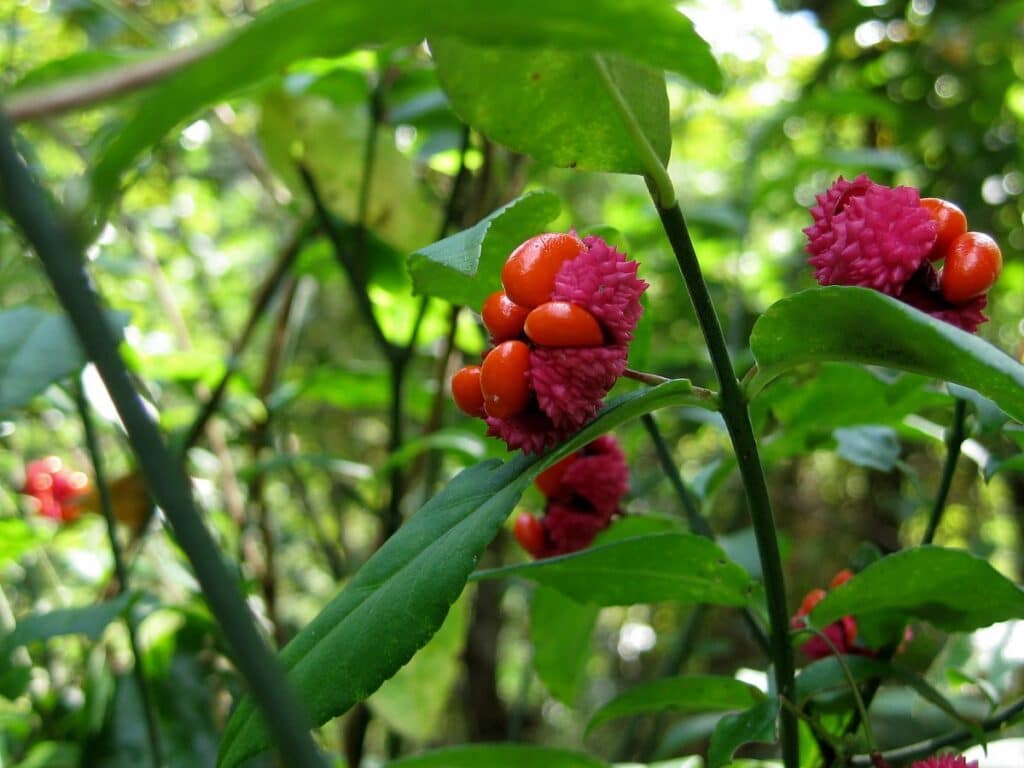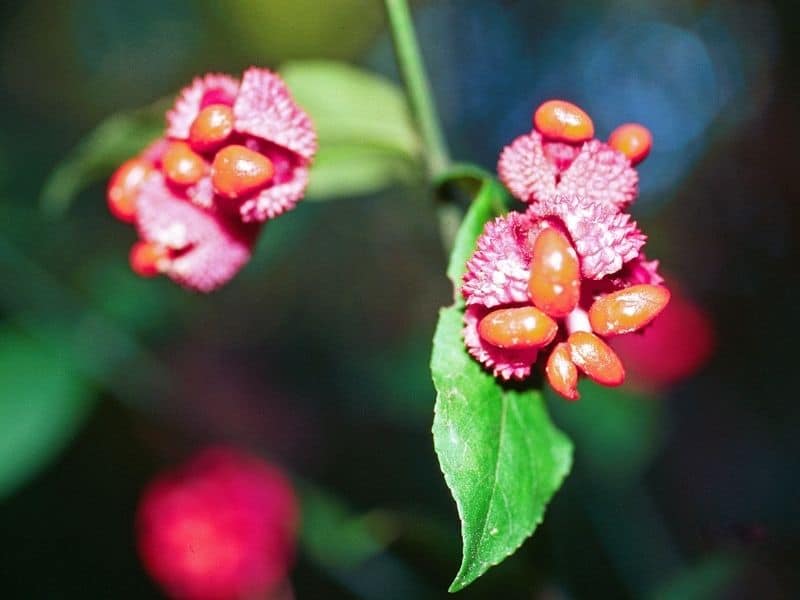The strawberry bush brings unique combinations of shapes and colors to the native garden. This plant has many interesting and attractive features, so let’s jump right in and get to know this fantastic shrub.
What Is A Strawberry Bush?
The strawberry bush (Euonymus americanus, E. americana) is an upright, multi-stemmed deciduous shrub. Its natural habitats are its streambanks, low sandy woods, moist understory forest areas, ravines, and wooded slopes from Florida to New York.

These plants, from the Celastraceae family, go by a number of interesting and descriptive common names including wahoo, American burning bush, bursting-heart, and hearts-a-bustin’.
These plants grow to heights of 2 to 8 ft (0.6 to 2.4 m) and are found in a variety of habitats, including along streams and in ravines as well as woodlands and thickets.
Hearts-a-bustin’ is native to the USA, where it occurs throughout many of the eastern states, and is also found in southeastern Canada.
The bright green leaves of this plant are 1 to 3.5 inches (2.5 to 9 cm) long and pointed on either end. They have serrated margins. While this plant is deciduous, the show it puts on before dropping its medium green leaves in winter is spectacular. The leaves will turn deep red in fall before dropping. (1)

In all seasons, the stems of this plant are a lovely green shade. The leaves and branchlets are oppositely arranged in this plant and its stems are often angular in profile, which you can feel if you roll a stem between your fingertips.
Strawberry Bush Flowers
Unfortunately, Strawberry bush flowers are not very showy, measuring about ⅓ inch (0.8 cm) across and developing on cymes on the current year’s growth.
Flowers bloom from March to June and have five pale green to greenish yellow petals and purple stamens.
The fruits of this plant are the real show-stoppers. These rounded pink capsules (which give the plant its common name) burst open, exposing bright scarlet seeds in the months of September and October.
How To Grow A Strawberry Bush
Strawberry bushes can be grown in a number of ways. Growing from seed is effective, but red orange seeds must be cold-stratified for 1 to 3 months before they will be fertile. (2)
These plants can also be grown from stem cuttings taken in the warmer months, while the plant holds leaves. Root division is another good way to grow new plants.
These plants can be grown in poorly drained moist soils but will definitely do better in well-drained soil that is rich in organic matter.
While they are moderately drought-resistant, this plant should be kept well watered and mulching is a good idea, especially in warmer and drier climates as it keeps the roots moist for longer.
The American strawberry shrub grows best in light shade, but it may handle partial shade to full sun. Grow these plants in USDA hardiness zones 6 to 9 and to UK zone 6.
Care and Maintenance

You can prune this low-maintenance plant quite heavily, but this usually isn’t necessary, unless you want to maintain a certain size.
Fertilizing isn’t really necessary either, provided you grow your strawberry bush in soil that is rich in organic matter.
Unfortunately, the strawberry bush is not without problems, and the euonymus scale and crown gall can affect this plant.
Some sources cite this plant as resistant or immune to the euonymus scale (Unaspis euonymi). To be safe, keep an eye out for these tiny insects on the leaf surfaces where they appear as whitish spots. This condition may need to be managed with pesticides.
Crown gall is a bacterial infection caused by agrobacterium tumefaciens. The crown, which is the part of the plant immediately above the soil line, is affected and galls or swelling will develop.
Often, these won’t kill the plants, but they are not attractive and do slow the plant’s growth.
Crown gall can be serious too, young and unestablished plants may be killed by this disease. Remove galls with your trimmers but remember to disinfect them before using them on other plants to prevent spreading the bacteria.
Uses
Horticultural Uses
The first record of this plant in cultivation stretches as far back as 1697. The strawberry bush has many potential uses in the garden but is probably best suited for natural-themed, native gardens. (3)
It can also be grown as an informal hedge or used in foundation and border plantings. These interesting native plants have multi-season interest and also make a fine specimen plants.
Human Uses
This plant has many traditional medicinal uses and has been used as a laxative and to cure stomach aches, malaria, and even dandruff.
Wildlife Uses
Depending on where you live, one important thing to know is that this plant is a favorite of white-tailed deer and cottontail rabbits. If these animals have access to your yard, consider protecting them behind a fence.
Some birds and small mammals enjoy eating the seeds and this is how the seeds are naturally distributed. Insects pollinate these spring flowers.
FAQs
What is the range of Euonymus Americanus?
Euonymus americanus, commonly known as American strawberry bush or hearts-a-burstin’, is native to the southeastern United States. Its range includes states such as Florida, Georgia, Alabama, Mississippi, and Louisiana.
How do you propagate Euonymus americanus?
Euonymus americanus can be propagated through seeds or stem cuttings. Seeds can be collected from the plant’s fruit and sown in well-draining soil. Stem cuttings can be taken in late spring or early summer, treated with a rooting hormone, and planted in a suitable growing medium.
Is euonymus poisonous to humans?
Some species of Euonymus, including certain varieties of Euonymus americanus, can be toxic to humans if ingested. It’s important to exercise caution and keep these plants out of reach, especially if there are young children or pets in the vicinity.
Does euonymus grow quickly?
Euonymus growth rate can vary depending on the specific species and growing conditions. Some Euonymus varieties are known for moderate to fast growth, making them popular choices for hedges and landscaping. Providing well drained soils, adequate sunlight, and proper care can contribute to a healthy and vigorous growth rate.
Conclusion
The strawberry bush has a lot of things going for it, with beautiful and interesting foliage, green stems, and fruits. This plant’s potential susceptibility to disease and its popularity with deer are definitely factors to consider.
For more bushes to grow, check these backyard bushes.
References
Reference List:
(1) Williams, Z. Strawberry bush, Euonymus Americana L. Plant Guide. https://plants.usda.gov/plantguide/pdf/pg_euam7.pdf
(2) Gilman, E. F. Euonymus Americana. FPS-203. http://hort.ufl.edu/database/documents/pdf/shrub_fact_sheets/euoamea.pdf
(3) Bonner, F. T. & Karrfalt, L. P. The Woody Plant Seed Manual. United States Department of Agriculture Handbook 727.
Close






